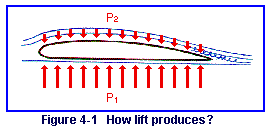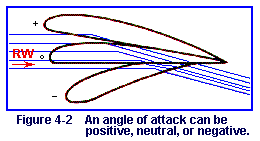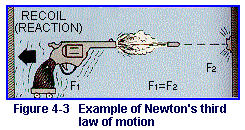 |
|||||
| Home | Research | For Teachers | HISTORY Level 1 Level 2 Level 3 |
PRINCIPLES Level 1 Level 2 Level 3 |
CAREER Level 1 Level 2 Level 3 |
| Gallery | Hot Links | What's New! | |||
| Web Administration and Tools | |||||
 |
|||||
| Home | Research | For Teachers | HISTORY Level 1 Level 2 Level 3 |
PRINCIPLES Level 1 Level 2 Level 3 |
CAREER Level 1 Level 2 Level 3 |
| Gallery | Hot Links | What's New! | |||
| Web Administration and Tools | |||||
![]()
We know that we can cause reduced pressure in a fluid if the velocity
of its flow is  increased (Based on Bernoulli's
principle - section 3-2 ).
increased (Based on Bernoulli's
principle - section 3-2 ).
The camber of an airfoil's upper surface makes the air flowing over it move faster than the air flowing under the wing. This increase in velocity reduces the pressure (P1>P2) on the top of the wing so lift is produced. (See Figure 4-1).
Lift is also called airfoil lift or Bernoulli's lift.
Lift will continue as long as the airfoil is moving through the air and the air remains smooth rather than turbulent.
Every airfoil, no matter what its camber or chord, will lose its smooth
flow at some point  along the upper surface. The perfect airfoil, if there were such a
thing, would have turbulent flow at its trailing edge where the divided airstream comes
together again. The regular airfoil has turbulence somewhere forward of the trailing edge
even though level flight is maintained. With every increase in angle of attack (See Figure
4-2), this turbulent flow moves farther and farther toward the leading edge. The increase
in angle of attack increases lift. This is true up to a point because we also must
consider the power needed to force the craft through the air. If we had unlimited power,
angle of attack would be of no concern, but this is not the normal situation so the
turbulent flow continues forward until there is no more lift available.
along the upper surface. The perfect airfoil, if there were such a
thing, would have turbulent flow at its trailing edge where the divided airstream comes
together again. The regular airfoil has turbulence somewhere forward of the trailing edge
even though level flight is maintained. With every increase in angle of attack (See Figure
4-2), this turbulent flow moves farther and farther toward the leading edge. The increase
in angle of attack increases lift. This is true up to a point because we also must
consider the power needed to force the craft through the air. If we had unlimited power,
angle of attack would be of no concern, but this is not the normal situation so the
turbulent flow continues forward until there is no more lift available.
It may interest you to know, at this point, that lift can also be created by an airfoil without any camber at all.
This lift, however, is completely different from the lift we have been talking about. This type of lift is called dynamic lift and is caused by the pressure of impact air against the lower surface of the airfoil.
A kite flying on a balmy spring day is an excellent example of an airfoil without camber being sustained in flight by dynamic lift. Similar to the airfoil in the wind tunnel, it makes no difference to the kite whether it is moving forward through the air or the air is moving past it. It simply goes on and hangs up there in the spring sky. (If you have flown a kite, however, you know there's a difference. You know that when the wind is light, you have to run your legs off at times to get the kite airborne.)
This same kind of lift also helps hold the aircraft in the air and can be explained by Newton's third law of motion.
 Newton's third law of motion states
that for every action there is an equal and opposite reaction. A popular example of this
law is the gun and the bullet shown in Figure 4-3. When the trigger is pulled and the gun
fires, the bullet leaving the barrel is the action and the recoil of the gun is the
reaction. If we can ignore friction and air resistance, the force of the bullet striking
the wall and the force of the gun striking the opposite wall will be equal.
Newton's third law of motion states
that for every action there is an equal and opposite reaction. A popular example of this
law is the gun and the bullet shown in Figure 4-3. When the trigger is pulled and the gun
fires, the bullet leaving the barrel is the action and the recoil of the gun is the
reaction. If we can ignore friction and air resistance, the force of the bullet striking
the wall and the force of the gun striking the opposite wall will be equal.
We've pointed out that air is a fluid. The passing of the airfoil through the air is an action. We can expect, then, that the air will act upon the wing. This is the reaction. The lower surface of the wing meets the air at a slight angle (the angle of attack, which we've already covered). The air flowing past the lower surface is deflected slightly. The wing exerts a force on the air in order to do this; the air, meanwhile, exerts an equal and opposite force on the wing. This force of the air (the reaction force) causes lift which is called dynamic lift. Sometimes, it is also called Newtonian lift or action-reaction lift.
The amount of lift generated by this action-reaction process usually amounts to only about 15 percent of the total lifting force necessary to sustain aircraft flight.
In this section, we have concentrated on how airfoils create lift. They make use of Bernoulli's principle and Newton's third law of motion. Airfoils move through the air, creating an interaction between air and airfoils. This interaction takes the form of a difference in pressure between upper and lower surfaces of the airfoil, and the decreased pressure on the upper surface of the airfoil causes lift. Additional lift comes from the force of the impact air on the airfoil moving through the air.
Send all comments to ![]() aeromaster@eng.fiu.edu
aeromaster@eng.fiu.edu
© 1995-98 ALLSTAR Network. All rights reserved worldwide.
| Funded in part by | From Civil Air Patrol Educational Materials |
Updated: February 23, 1999